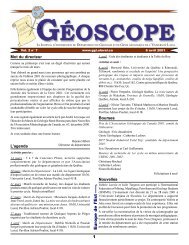Mot du directeur Agenda Conférences - Département de géologie et ...
Mot du directeur Agenda Conférences - Département de géologie et ...
Mot du directeur Agenda Conférences - Département de géologie et ...
You also want an ePaper? Increase the reach of your titles
YUMPU automatically turns print PDFs into web optimized ePapers that Google loves.
VBA, fonctionnant sous le logiciel MS Excel <strong>et</strong> prenant en compte<br />
les paramètres physico-chimiques <strong>et</strong> économiques, a été mis au<br />
point. Ce programme (PITEM) <strong>de</strong> part sa simplicité <strong>et</strong> sa flexibilité<br />
se <strong>de</strong>ssine comme un outil <strong>de</strong> base dans divers domaines <strong>et</strong> pour le<br />
développement d’autres modèles.<br />
<strong>Mot</strong>s clés : Métaux lourds, Spéciation chimique, Simulation,<br />
Progiciel, Ms Excel.<br />
20 novembre. Séminaire INRS-ETE / CGC-Q. Jean-<br />
Philippe Belenger, Princ<strong>et</strong>on Environmental Institute, Princ<strong>et</strong>on<br />
University.<br />
Lieu: salle 2417, INRS-ETE.<br />
Titre<br />
Recent <strong>de</strong>velopments on m<strong>et</strong>al acquisition and homeostasis by<br />
free-living nitrogen fixers; Implications for the nitrogen cycle<br />
within terrestrial environments?<br />
Résumé<br />
Since trace m<strong>et</strong>als bioavailability, while potentially toxic, affects<br />
key enzymatic activities, the cycling ofm<strong>et</strong>al in the environment<br />
can play critical role in impacting the cycling of major nutrients<br />
such as nitrogen or carbon. N2 fixation, which is the main natural<br />
route of entry of new nitrogen to ecosystems, is catalyzed by the<br />
enzyme nitrogenase in a few prokaryotes. Three nitrogenases have<br />
thus far been i<strong>de</strong>ntified (Mo-, V- and Fe-Nase). Interestingly, besi<strong>de</strong><br />
the well studied iron, the acquisition andhomeostasis of Mo<br />
and V are still poorly known likely resulting in misconception of<br />
the terrestrial nitrogen cycle. Here, I present an overview of recent<br />
findings on trace m<strong>et</strong>als (Mo, V and Fe), requirements, uptake<br />
and homeostasis by free-living nitrogen fixing bacteria. Our data<br />
show that si<strong>de</strong>rophores, which are small organic ligands excr<strong>et</strong>ed<br />
by the bacteria, are used to acquire molyb<strong>de</strong>num and vanadium, in<br />
addition to their traditional role in iron acquisition. These results<br />
resolve the long standing <strong>de</strong>bate regarding the existence of<br />
molybdophores, as well as the corollary question regarding<br />
vanadophores. Further, “si<strong>de</strong>rophores”, (which are really<br />
m<strong>et</strong>allophores) are also used to bind m<strong>et</strong>als and <strong>de</strong>crease their<br />
toxicity at high concentrations. Thus, si<strong>de</strong>rophores are used either<br />
to increase the bioavailability of m<strong>et</strong>als or (and) to <strong>de</strong>crease their<br />
toxicity and contribute significantly to the homeostasisof m<strong>et</strong>als.<br />
Our finding also shows that the efficiency of the V- nitrogenase is<br />
close to that of the Mo-nitrogenase, which is usually consi<strong>de</strong>red<br />
to be dominant in terrestrial ecosystems. Since soils V concentrations<br />
are about 100 times higher than those of Mo, nitrogen fixers<br />
might benefit from being able to utilize this additional m<strong>et</strong>al source.<br />
This, and recent work, including ours, showing that Mo may be<br />
limiting N2 fixation in a vari<strong>et</strong>y of terrestrial systems suggest that<br />
the worldwi<strong>de</strong> dominance of Mo–nitrogenase may have been overestimated<br />
in terrestrial environments, and that alternative nitrogenases,<br />
associated to free-living nitrogen fixers, need to be taken<br />
into account to un<strong>de</strong>rstand the present nitrogen cycle in soils and<br />
2<br />
to anticipate the possible responses of terrestrial environments to<br />
global change.<br />
25 novembre. Pierre Andrieux, Université Pierre <strong>et</strong> Marie Curie<br />
(Paris VI).<br />
Lieu: salle 1444 Pavillon La Laurentienne.<br />
Titre<br />
Les ressources énergétiques <strong>et</strong> minérales en France, en Europe <strong>et</strong><br />
dans le mon<strong>de</strong><br />
Résumé<br />
Il n’y aura plus <strong>de</strong> pétrole ni <strong>de</strong> gaz à la fin <strong>du</strong> 21ème siècle. Le<br />
charbon «propre» sera très présent au cours <strong>de</strong>s <strong>de</strong>ux siècles à<br />
venir. Le nucléaire ne peut en aucun cas, contribuer à plus <strong>de</strong> 25 %<br />
<strong>de</strong> la consommation mondiale d’énergie en 2050. Les réserves<br />
mondiales d’uranium sont limitées.<br />
Ces prévisions relèvent-elles <strong>du</strong> politique, <strong>de</strong> l’économique ou <strong>de</strong>s<br />
géosciences ?<br />
Les mêmes questions se posent pour les métaux ferreux <strong>et</strong> non<br />
ferreux, les métaux précieux, les granulats <strong>et</strong> toutes les substances<br />
minérales in<strong>du</strong>strielles.Les géosciences ont un rôle clé à jouer pour<br />
l’avenir <strong>de</strong> la Planète.<br />
2 décembre. Séminaire INRS-ETE / CGC-Q. Fateh Chebana,<br />
INRS-ETE.<br />
Lieu: salle 2417, INRS-ETE.<br />
Titre<br />
Analyse fréquentielle régionale <strong>de</strong>s crues: une nouvelle approche<br />
basée sur les fonctions profon<strong>de</strong>ur<br />
Résumé<br />
En analyse fréquentielle régionale <strong>de</strong>s crues, la restriction à une<br />
région particulière correspond à une perte d’information. De plus<br />
la définition d’une région pro<strong>du</strong>it un eff<strong>et</strong> <strong>de</strong> frontière (<strong>de</strong> bord).<br />
Pour surmonter ces difficultés, une nouvelle métho<strong>de</strong> est proposée<br />
pour le modèle <strong>de</strong> régression. C<strong>et</strong>te métho<strong>de</strong> se base sur trois<br />
éléments: (i) une fonction <strong>de</strong> poids pour traiter l’eff<strong>et</strong> <strong>de</strong> bord, (ii)<br />
une fonction pour évaluer le <strong>de</strong>gré <strong>de</strong> similarité <strong>de</strong> chacun <strong>de</strong>s<br />
sites par rapport au site cible, <strong>et</strong> (iii) une procé<strong>du</strong>re itérative pour<br />
améliorer les résultats <strong>de</strong> l’estimation. Les approches classiques<br />
représentent <strong>de</strong>s cas particuliers <strong>de</strong> la présente approche. Outre sa<br />
souplesse <strong>et</strong> sa généralité, la métho<strong>de</strong> proposée pro<strong>du</strong>it <strong>de</strong><br />
meilleures estimations que celles obtenues par l’approche <strong>de</strong><br />
l’analyse <strong>de</strong>s corrélations canoniques. Enfin, la métho<strong>de</strong> est<br />
générale <strong>et</strong> peut s’avérer utile quand le modèle <strong>de</strong> régression est



